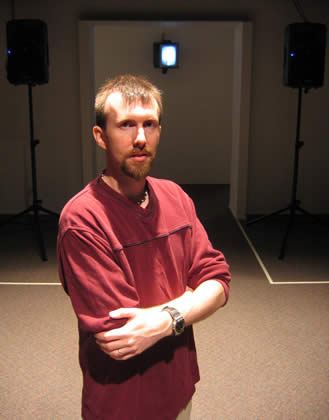The Sounds of Movement
Text originally published in Eye on Ideas Vol. 2/1 (2006). Republished in eContact! with the kind permission of Eye on Ideas.
Both the left and the right hemispheres of Philip Baer’s brain evidently function at a high level. He’s a fine artist, though much of his undergraduate studies at the UofC were spent experimenting with computers and programs like Photoshop. In creating his graduating thesis for his Interdisciplinary Master’s degree in Art and Music, he tailored computer software to handle the interactive sound/motion component of his work. “Yeah, I could be computer programming and making money,” he says with a wry smile, “but I was drawn to art. I guess it’s my interest in ideas and in exploring what life has to offer.”
His idea of capturing the movements of the body and translating them to sound has captured the imagination of artists, choreographers and dancers across Calgary. It was displayed much like an art installation exhibit at the Nickle Arts Museum last summer, as a dance performance at the Epcor Centre’s Big Secret Theatre last Fall, and will be showing at the Bird and Stone Theatre in the Spring of 2007.

The exhibit is displayed as a dark room with a pool of light centred on the “audience” or performer of one, who enters the space. A video camera is placed on the ceiling pointing down at the floor space below. The camera’s field of view is defined within lines that demarcate the space. Surrounding the space are eight stands holding sound speakers.
“Technology goes really well with any movement type performance,” Baer explains. “I used video cameras as a motion tracking technology as opposed to sensors attached to the body because I wanted the performer, or participant in the work, to be able to have complete freedom of movement. It’s meant to create a real experience for the person who enters the space.”
Baer harks back to the pioneer of art installations Marcel Duchamp who was doing interactive work in the early 20th century that was mechanical rather than technology based. “One of his more famous pieces was Bicycle Wheel, that was exhibited in 1914. It was a stand on which an axel was mounted, so the audience member could spin it and be mesmerized by the pattern of the spokes on the wheel.”
What happens as the performer enters Baer’s art space is that their movements come alive through sound. Baer got technically creative, or creatively technical, with the assignment of sounds. “The sounds are all recorded sounds of voice based on the phonetic sounds of the English language and so 44 are unique phonemes. The 44 sounds were then reproduced four times over. Half of the sounds were whispered and half spoken, and then each of those sets of sounds were subjected to further sound processing in the studio. I devised a technique that I call spectral morphing. It’s a way of infusing one sound with the spectral properties of another. For example I used percussion sounds and sounds of a metal rod scraping on plate glass and mixed these with the recorded voices.”
The computer software Baer used to create the interactivity component was the Max/MSP software program —essentially graphical software that can be used to create other software. Though he’s had training in Max/MSP, Baer’s university studies haven’t included computer science. His interest in programming, however, was instilled at a very young age. “I was lucky enough to start learning about computers and programming in Grade 2!”
Baer’s work is influenced by his curiosity in the theoretical concept of synæsthesia — the input that one sensory experience has on another sensory experience. For example, a person hears a sound that produces a visualization of a colour. “I’m particularly interested in the case of vision and audition…there is an inherent interactivity between sound and images.”
Baer’s graduate supervisors are professor Paul Woodrow in Art and Dr. David Eagle in Music, and his work has been partially funded through Graduate Research Scholarships and the Calgary Arts Development.
Though Baer works extensively with dancers, choreographers and more recently a composer, he doesn’t consider himself a performer, rather someone with a broad range of interests. “I’m always reading philosophy,” he says, citing Jean Baudrillard as one of his current favourites.
Jean Baudrillard is a social theorist best known for his analyses of modes of mediation technological communication.
Given his eclectic interests and passion for exploring life, it’s not surprising that Baer is considering a PhD in electroacoustic music, with a focus on interactivity.
Social top